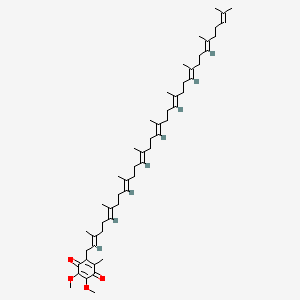| Authors | Title | Published | Journal | PubMed Link |
|---|---|---|---|---|
| Duncan AJ et al. | A nonsense mutation in COQ9 causes autosomal-recessive neonatal-onset primary coenzyme Q10 deficiency: a potentially treatable form of mitochondrial disease. | 2009 | Am. J. Hum. Genet. | pmid:19375058 |
| Kocsis GF et al. | Lovastatin interferes with the infarct size-limiting effect of ischemic preconditioning and postconditioning in rat hearts. | 2008 | Am. J. Physiol. Heart Circ. Physiol. | pmid:18359895 |
| Shelley P et al. | Altered skeletal muscle insulin signaling and mitochondrial complex II-III linked activity in adult offspring of obese mice. | 2009 | Am. J. Physiol. Regul. Integr. Comp. Physiol. | pmid:19535678 |
| Saiki R et al. | Coenzyme Q10 supplementation rescues renal disease in Pdss2kd/kd mice with mutations in prenyl diphosphate synthase subunit 2. | 2008 | Am. J. Physiol. Renal Physiol. | pmid:18784258 |
| Palmeira CM et al. | Enhanced mitochondrial testicular antioxidant capacity in Goto-Kakizaki diabetic rats: role of coenzyme Q. | 2001 | Am. J. Physiol., Cell Physiol. | pmid:11502580 |
| Teshima K and Kondo T | Analytical method for ubiquinone-9 and ubiquinone-10 in rat tissues by liquid chromatography/turbo ion spray tandem mass spectrometry with 1-alkylamine as an additive to the mobile phase. | 2005 | Anal. Biochem. | pmid:15707930 |
| Vadhanavikit S et al. | Quantitative determination of coenzyme Q10 in human blood for clinical studies. | 1984 | Anal. Biochem. | pmid:6517310 |
| Nakase T and Suzuki M | Sporobolomyces yuccicola, a new species of ballistosporous yeast equipped with ubiquinone-9. | 1988 | Antonie Van Leeuwenhoek | pmid:3389771 |
| Zahiri HS et al. | Biochemical characterization of the decaprenyl diphosphate synthase of Rhodobacter sphaeroides for coenzyme Q10 production. | 2006 | Appl. Microbiol. Biotechnol. | pmid:16896603 |
| Hsieh EJ et al. | Saccharomyces cerevisiae Coq9 polypeptide is a subunit of the mitochondrial coenzyme Q biosynthetic complex. | 2007 | Arch. Biochem. Biophys. | pmid:17391640 |
Coenzyme Q9
Coenzyme q9 is a lipid of Prenol Lipids (PR) class. The involved functions are known as Diastasis, Phosphorylation and Cardiac function.
Cross Reference
Introduction
To understand associated biological information of Coenzyme Q9, we collected biological information of abnormalities, associated pathways, cellular/molecular locations, biological functions, related genes/proteins, lipids and common seen animal/experimental models with organized paragraphs from literatures.
What diseases are associated with Coenzyme Q9?
There are no associated biomedical information in the current reference collection.
No disease MeSH terms mapped to the current reference collection.
PubChem Associated disorders and diseases
What pathways are associated with Coenzyme Q9
There are no associated biomedical information in the current reference collection.
PubChem Biomolecular Interactions and Pathways
Link to PubChem Biomolecular Interactions and PathwaysWhat cellular locations are associated with Coenzyme Q9?
There are no associated biomedical information in the current reference collection.
What functions are associated with Coenzyme Q9?
Related references are published most in these journals:
| Function | Cross reference | Weighted score | Related literatures |
|---|
What lipids are associated with Coenzyme Q9?
There are no associated biomedical information in the current reference collection.
What genes are associated with Coenzyme Q9?
There are no associated biomedical information in the current reference collection.
What common seen animal models are associated with Coenzyme Q9?
There are no associated biomedical information in the current reference collection.
